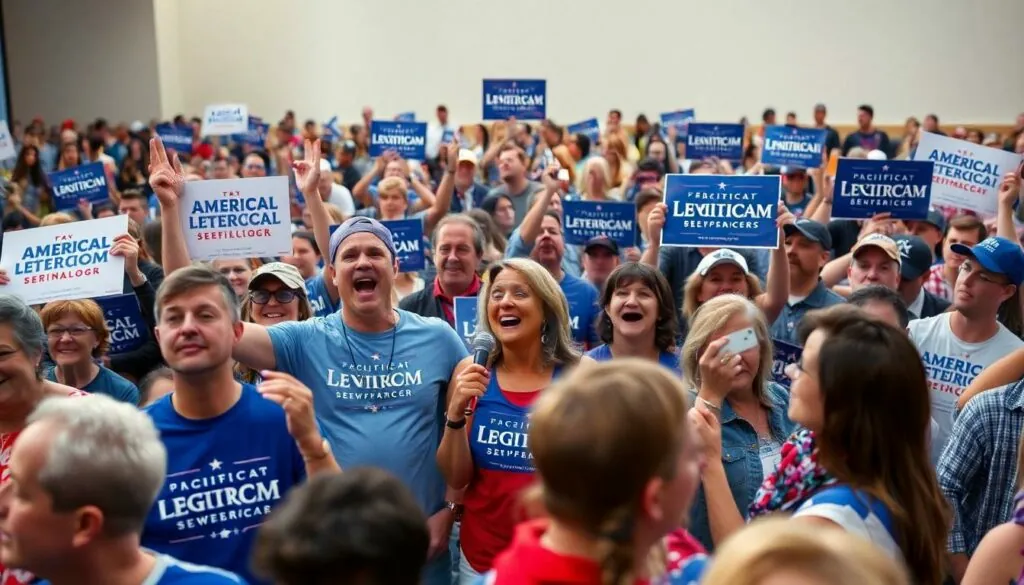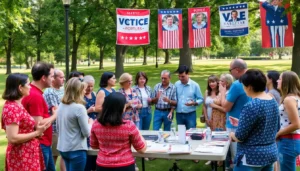Political campaigns are like the Super Bowl of democracy, where candidates battle it out for the ultimate prize: your vote. These high-stakes contests transform ordinary citizens into passionate supporters, rallying behind their favorite contenders with fervor that rivals sports fandom. But what exactly goes into these campaigns?
Table of Contents
ToggleUnderstanding Political Campaigns
Political campaigns play a crucial role in modern democracy. They serve as the platform through which candidates communicate their visions and policies to the electorate.
Definition of Political Campaigns
Political campaigns consist of organized efforts by candidates or political parties aimed at gaining public support during elections. These efforts include rallies, advertisements, debates, and grassroots outreach. Typically, campaigns highlight key issues, showcasing candidates’ stances to influence voter decisions. Candidates rely on various strategies, using media and direct interactions to reach voters, ultimately aiming to secure electoral victories.
Importance of Political Campaigns
Political campaigns significantly impact civic engagement and voter turnout. They inform the public about candidates’ positions, helping citizens make educated choices. Competitiveness within campaigns energizes communities, encouraging people to participate in the electoral process. Campaigns also facilitate dialogue on pressing issues, allowing diverse perspectives to surface. Engaging with the electorate fosters accountability, as candidates must respond to constituents’ needs and concerns while honing their platforms to win support.
Types of Political Campaigns

Political campaigns take various forms, each tailored to specific electoral contexts. Understanding these types aids in grasping their impact on the democratic process.
Local Elections
Local elections involve candidates competing for positions within city councils, school boards, and local governments. These campaigns often focus on community-specific issues such as education, public safety, and infrastructure. Often, candidates engage directly with constituents through town hall meetings and door-to-door canvassing. Grassroots efforts play a significant role, encouraging residents to participate in local governance. Candidates aim to build strong relationships with voters, addressing their unique needs and concerns.
National Elections
National elections center around high-profile positions like the presidency and congressional seats. Campaigns for these offices typically utilize extensive media outreach, including television advertisements, social media platforms, and nationwide rallies. The stakes are significantly higher, as candidates convey their platforms on key issues such as healthcare, immigration, and economic policy. Voter mobilization becomes crucial in these campaigns, often involving sophisticated data analytics to target specific demographics. Candidates strive to create a compelling narrative that resonates with a diverse electorate.
Issue-Based Campaigns
Issue-based campaigns focus on specific concerns rather than individual candidates or parties. These efforts often arise in response to social movements or public policy debates, emphasizing topics like climate change, healthcare reform, and civil rights. Advocates develop clear messaging to raise awareness and engage supporters. Demonstrations, petitions, and educational initiatives serve as tools to further the cause. Success hinges on the ability to mobilize public opinion and influence policymakers toward favorable outcomes. Each campaign aims to create lasting change in the political landscape through focused advocacy.
Key Elements of Political Campaigns
Political campaigns rely on several key elements that work together to maximize effectiveness and reach. These components include campaign strategy, fundraising and budgeting, and voter outreach and engagement.
Campaign Strategy
Campaign strategy serves as the roadmap for any political campaign. It defines goals, identifies target demographics, and outlines messaging. Developing a strong strategy involves careful analysis of the political landscape, selecting key issues, and leveraging the strengths of the candidate or party. Effective strategies utilize various media channels for outreach, such as social media, television, and traditional print. Monitoring the campaign’s progress and adjusting the strategy as needed also ensures alignment with voter sentiments and emerging issues.
Fundraising and Budgeting
Fundraising and budgeting play integral roles in the success of political campaigns. Financial resources are essential for advertising, staff salaries, and event organization. Campaigns often rely on contributions from individual donors, political action committees, and fundraising events. Establishing a realistic budget allows campaigns to allocate funds effectively across initiatives, ensuring maximum impact. Transparency in fundraising practices fosters trust with voters and can lead to increased support.
Voter Outreach and Engagement
Voter outreach and engagement are crucial for garnering support during elections. Campaigns utilize various methods to connect with constituents, including door-to-door canvassing, phone banking, and community events. Engaging with voters encourages dialogue around key issues and helps candidates understand constituents’ needs. Social media platforms also serve as valuable tools for disseminating information and rallying grassroots support. Innovative outreach efforts can significantly boost voter turnout and enhance civic participation during elections.
Role of Media in Political Campaigns
Media plays a vital role in shaping political campaigns. It serves as a conduit between candidates and the electorate, helping to inform, persuade, and engage voters.
Traditional Media
Traditional media encompasses television, radio, and print outlets. These platforms provide candidates with opportunities to reach broad audiences. Television ads can deliver clear messages to millions quickly, while newspaper endorsements can lend credibility. Candidates often hold press conferences to control their narratives, ensuring they address key issues directly. News coverage offers a real-time examination of campaign events, influencing public perception. Voters rely on these sources to gain insights into candidate positions and campaign developments, making traditional media an essential component of any political strategy.
Social Media Influence
Social media reshapes how campaigns interact with constituents. Platforms like Twitter, Facebook, and Instagram enable direct communication between candidates and voters. Campaigns leverage these channels to share updates, rally supporters, and respond to opponents in real time. Engaging content can go viral, amplifying reach beyond traditional measures. Statistics show that a significant number of voters consume political information online, making social media a critical battleground. Moreover, targeted ads on these platforms allow campaigns to tailor messages to specific demographics, increasing the effectiveness of outreach efforts.
Challenges Faced in Political Campaigns
Political campaigns encounter numerous challenges that can impact their effectiveness and outcomes. Among these hurdles, voter apathy and misinformation stand out as significant obstacles.
Voter Apathy
Voter apathy reflects a lack of interest or motivation to participate in elections. Many citizens feel disillusioned with the political process, often questioning whether their votes truly matter. Low voter turnout during elections highlights this issue, with the U.S. Census Bureau noting that only about 66% of eligible voters participated in the 2020 presidential election. Engaging these disenchanted voters requires campaigns to foster meaningful connections. Tailoring messages that resonate with individuals’ concerns can revive interest. Addressing local issues also helps create relevance, motivating citizens to support candidates who align with their values.
Misinformation
Misinformation presents another critical challenge in political campaigns. The rapid spread of false information, especially on social media, can mislead voters and distort perceptions of candidates or issues. Research conducted by the Pew Research Center indicates that over 50% of Americans encountered false information during the 2020 election. Addressing this issue involves proactive strategies, such as fact-checking and transparent communication. Campaigns must take steps to clarify misinformation through official channels. Educating voters on identifying credible sources also plays an essential role in combating false narratives.
Political campaigns are vital to the democratic process as they energize citizens and foster engagement. They serve as a platform for candidates to connect with voters and address pressing issues. Through various strategies and media channels campaigns not only inform the public but also encourage active participation in elections.
Despite challenges like voter apathy and misinformation campaigns continue to adapt and innovate. By focusing on transparency and meaningful outreach they can bridge gaps and build trust with constituents. Ultimately political campaigns shape the political landscape and empower voters to make informed choices.





